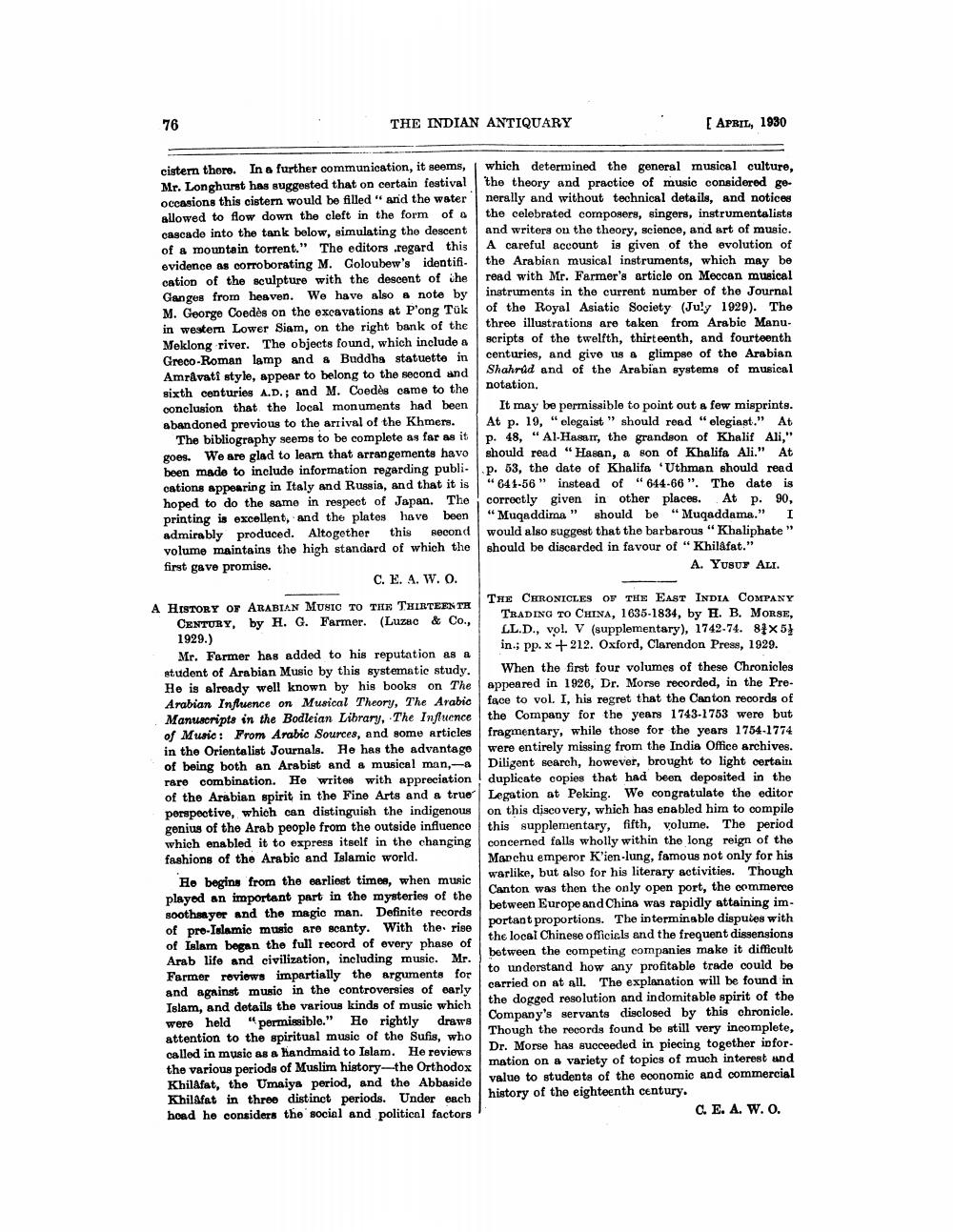________________
THE INDIAN ANTIQUARY
APRIL, 1930
cistern thero. In a further communication, it seems, Mr. Longhurst has suggested that on certain festival occasions this cistern would be filled "and the water allowed to flow down the cleft in the form of cascade into the tank below, simulating the descent of a mountain torrent." The editors .regard this evidence as corroborating M. Coloubew's identifi. cation of the sculpture with the descent of ihe Ganges from heaven. We have also a note by M. George Coedès on the excavations at Pong Tuk in western Lower Siam, on the right bank of the Meklong river. The objects found, which include a Greco-Roman lamp and a Buddha statuette in Amråvati style, appear to belong to the second and sixth centuries A.D.; and M. Coedès came to the conclusion that the local monuments had been abandoned previous to the arrival of the Khmers.
The bibliography seems to be complete as far as it goes. We are glad to learn that arrangements havo been made to include information regarding public cations appearing in Italy and Russia, and that it is hoped to do the same in respect of Japan. The printing is excellent, and the plates have been admirably produced. Altogether this second volume maintains the high standard of which the first gave promise.
C. E. 4. W. O.
which determined the general musical culture. the theory and practice of music considered generally and without technical details, and notices the celebrated composers, singers, instrumentalists and writers on the theory, science, and art of music. A careful account is given of the evolution of the Arabian musical instruments, which may be read with Mr. Farmer's article on Meccan musical instruments in the current number of the Journal of the Royal Asiatic Society (July 1929). The three illustrations are taken from Arabic Manu. scripts of the twelfth, thirteenth, and fourteenth centuries, and give us a glimpse of the Arabian Shahrúd and of the Arabian systems of musical notation.
It may be permissible to point out a few misprints. At p. 19,"olegaist" should read "elegiast." At p. 48, "Al-Hasary, the grandson of Khalif Ali," should read "Hasen, a son of Khalifa Ali." At p. 53, the date of Khalifa 'Uthman should read “641-56" instead of "644-66". The date is correctly given in other places. At p. 90, "Muqaddima" should be "Muqaddama." I would also suggest that the barbarous "Khaliphate" should be discarded in favour of "Khilafat."
A. YUSUF ALI.
A HISTORY OF ARABIAN MUSIC TO TIE THIRTEEN TX
CENTURY, by H. G. Farmer. (Luzac & Co., 1929.)
Mr. Farmer has added to his reputation as a student of Arabian Music by this systematic study. He is already well known by his books on the Arabian Influence on Musical Theory, The Arabic Manuscripts in the Bodleian Library, The Influence of Music : From Arabic Sources, and some articles in the Orientalist Journals. He has the advantage of being both an Arabist and a musical man, rare combination. He writes with appreciation of the Arabian spirit in the Fine Arts and a true perspective, which can distinguish the indigenous genius of the Arab people from the outside influence which enabled it to express itself in the changing fashions of the Arabic and Islamic world.
He begins from the earliest times, when music played an important part in the mysteries of the soothsayer and the magic man. Definite records of pro-Islamic music are scanty. With the rise of Islam began the full record of every phase of Arab life and civilization, including music. Mr.
sie M Farmer roviows impartially the arguments for and against music in the controversies of early Islam, and details the various kinds of music which were held "permissible." He rightly draws attention to the spiritual music of the Sufis, who called in music as a Handmaid to Islam. He reviews the various periods of Muslim history--the Orthodox Khilafat, the Umaiya period, and the Abbasido Khilafat in three distinct periods. Under each hond he considers the social and political factors
THE CHRONICLES OF THE EAST INDIA COMPANY
TRADING TO CHINA, 1635-1834, by H. B. MORSE, LL.D., vol. V (supplementary), 1742.74. 84 x 5} in.; pp. +212. Oxford, Clarendon Press, 1929.
When the first four volumes of these Chronicles appeared in 1926, Dr. Morse recorded, in the Preface to vol. I, his regret that the Canton records of the Company for the years 1743-1753 were but fragmentary, while those for the years 1754-1774 were entirely missing from the India Office archives. Diligent search, however, brought to light certain duplicate copies that had been deposited in the Legation at Peking. Wo congratulate the editor on this discovery, which has enabled him to compile this supplementary, fifth, volume. The period concerned falls wholly within the long reign of the Manchu emperor K'ien-lung, famous not only for his warlike, but also for his literary activities. Though Canton was then the only open port, the commerce between Europe and China was rapidly attaining im. portant proportions. The interminable disputes with the local Chinese officials and the frequent dissensions between the competing companies make it difficult bet to undorstand how any profitable trade could be carried on at all. The explanation will be found in the dogged resolution and indomitable spirit of the Company's servants disclosed by this chronicle. Though the records found be still very incomplete, Dr. Morse has succeeded in piecing together infor. mation on a variety of topics of much interest and value to students of the economic and commercial history of the eighteenth century.
C. E. A. W.o.




